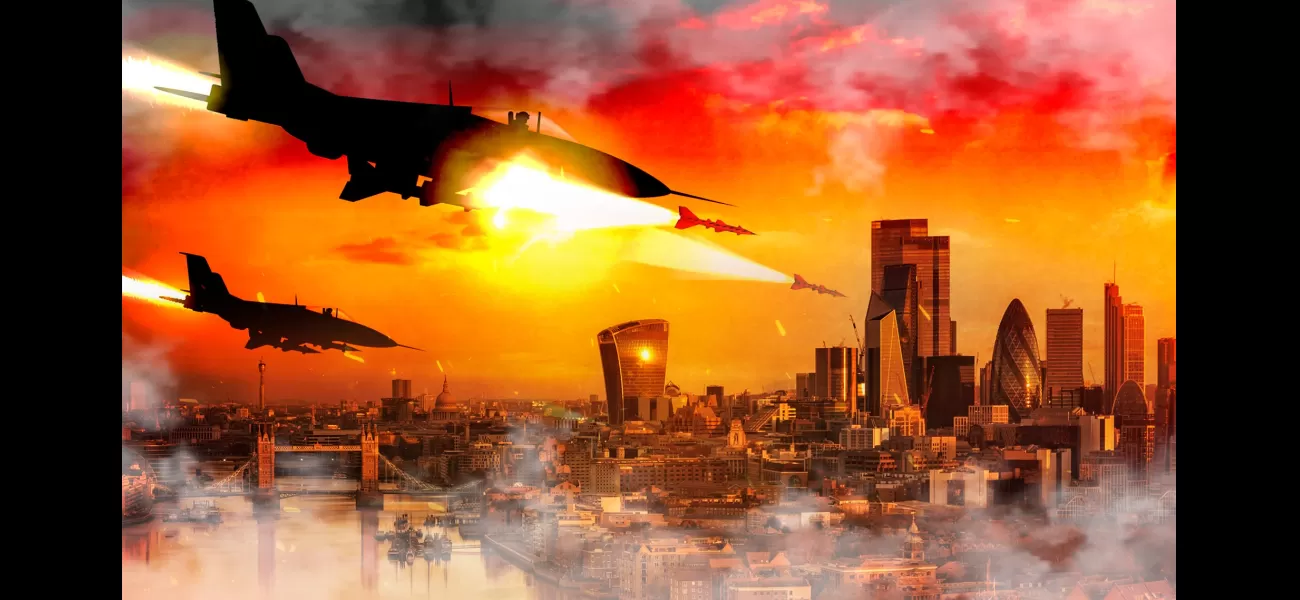Is London prepared for World War Three? Experts say urgent changes are necessary to ensure safety in the capital.
If you get hit while in a Tube station, you're in big trouble.
February 4th 2024.

Is London prepared for the possibility of war? According to experts, the answer is concerning. As tensions rise between a Russian leader and the western world, Londoners are living in a state of constant fear. The thought of a foreign enemy attacking their beloved city at any moment is terrifying.
Last year, Vladimir Putin issued a warning to Britain, threatening to unleash "serious consequences." His angry tirade accused Britain's elite forces of interfering with his nuclear power plants. Coming from a country known for its nuclear weapons and highly trained soldiers, this threat sent shivers down the spines of Londoners. As one of Europe's most prominent cities and home to a significant portion of the UK's population, it is likely that London would be at the top of Putin's "hit list."
However, this is not the first time the UK has faced a threat from an outside force. During World War II, the country united with the famous "Blitz spirit" to combat attacks from Nazi Germany. Later, during the Cold War, they prepared for the possibility of a covert conflict. But now, in the face of potential war, the threats have evolved, and the people of Britain must adapt to new forms of warfare, including advanced technology, cyber attacks, and the murky world of artificial intelligence.
As the future remains uncertain, London must be prepared to face these risks if Putin follows through with his threats. But what should Londoners do in the event of an attack? Many may think to seek shelter in the London Underground stations, but this may not be the best course of action. Nick Cooper, author of "London Underground at War," warns against this idea. He explains that most tube stations are close to ground level and could potentially lead to more deaths if hit directly. The stations are mainly made of bricks and concrete, which would collapse and crush anyone inside if struck by a bomb. Cooper also points out that those seeking shelter in stations near water works may be at risk of drowning, as seen in 1940 when a bomb hit Balham station, killing 67 people.
For the best protection against aerial attacks, Londoners should consider the use of Anderson shelters. These iron shelters were used during World War II and proved to be the most effective in protecting against bombs. However, the government would need to assist households in constructing them. Cooper explains that Anderson shelters bend upon impact, rather than shattering like other structures, making them a safer option.
In the event of war, evacuations may also be necessary. During World War II, over three million children were evacuated from London and other cities in "Operation Pied Piper." However, if another war were to break out, Londoners would likely be encouraged to stay in the city. This would not only help keep the city functioning but also prevent mass migration from clogging up other parts of the UK. Dr. Martin Farr, a senior history lecturer at Newcastle University, explains that during the Cold War, there were no evacuations outside of London, even with the threat of being nuked. In fact, people were actively encouraged to stay in their homes and take shelter in places like the cupboard under the staircase.
Keeping London running would be a top priority for the government during a war. Major services, such as transportation and manufacturing, would need to continue to keep Britain functioning. Just as during World War II, officials would not want people to live in fear and would encourage them to carry on with their normal routines. Londoners' resilience and determination would be crucial in keeping the city going during a time of crisis.
The question on everyone's mind is: are Londoners prepared for the possibility of war? According to experts, the answer is concerning. As tensions rise between a Russian dictator and the Western world, the citizens of London are living in a state of fear, dreading the moment when their city could come under attack by a foreign enemy.
Last year, Vladimir Putin issued a warning to Britain, threatening serious consequences. This sparked fear in the hearts of Londoners, knowing that Russia possesses a powerful nuclear arsenal and a highly-trained military force. As one of Europe's most prominent cities and home to a significant portion of the UK's population, London would likely be at the top of Putin's hit list.
This is not the first time that the UK has faced a threat from outside its borders. In the 1940s, the country came together with a strong sense of resilience and determination during the Blitz, when Nazi Germany targeted the nation. And during the Cold War, the UK braced itself for potential conflict in the shadows.
However, in today's world, the threats faced by the UK have evolved. Londoners must now be prepared to fight on multiple fronts, including cyber attacks, advanced weaponry, and the elusive world of artificial intelligence. As we face an uncertain future, these are the risks that London must be ready to confront if Putin follows through on his threats.
When it comes to seeking shelter during a potential attack, taking cover in London Underground stations may seem like a logical choice. However, this may not be the safest option. As seen in the past, many stations are located close to ground level and could potentially collapse if hit directly by a bomb. Additionally, some stations are near water works, putting those seeking shelter at risk of drowning. In fact, during the Blitz, a bomb hit Balham station, resulting in the deaths of 67 people due to flooding from the surrounding sewage system.
While some stations are deeper underground and may offer more protection, the best defense against aerial bombs is an Anderson shelter. These iron structures were used in people's gardens during World War II and proved to be the most effective in withstanding impacts. However, the government would need to assist households in building these shelters.
In the past, during times of war, children were often evacuated from London and other cities to protect them from air raids. However, in the case of a potential war today, it is unlikely that Londoners would be encouraged to leave the city. Instead, adults and children would be encouraged to stay and keep the city running to avoid overcrowding in other parts of the UK. During the Cold War, there were no official evacuations outside of London, and people were urged to stay in their homes or take cover in designated areas.
In the event of a war, the government's top priority would be to ensure that essential services remain operational to keep the country functioning. This includes everything from transportation to manufacturing. During previous wars, officials understood the importance of maintaining a sense of normalcy for Londoners and encouraged them to continue with their daily routines.
In conclusion, while the threats to London and the UK may have changed in the past century, the city must adapt and be ready to face them head-on. Whether it is seeking shelter, staying put, or keeping the city running, Londoners must be prepared for the potential challenges that may come their way.
Last year, Vladimir Putin issued a warning to Britain, threatening to unleash "serious consequences." His angry tirade accused Britain's elite forces of interfering with his nuclear power plants. Coming from a country known for its nuclear weapons and highly trained soldiers, this threat sent shivers down the spines of Londoners. As one of Europe's most prominent cities and home to a significant portion of the UK's population, it is likely that London would be at the top of Putin's "hit list."
However, this is not the first time the UK has faced a threat from an outside force. During World War II, the country united with the famous "Blitz spirit" to combat attacks from Nazi Germany. Later, during the Cold War, they prepared for the possibility of a covert conflict. But now, in the face of potential war, the threats have evolved, and the people of Britain must adapt to new forms of warfare, including advanced technology, cyber attacks, and the murky world of artificial intelligence.
As the future remains uncertain, London must be prepared to face these risks if Putin follows through with his threats. But what should Londoners do in the event of an attack? Many may think to seek shelter in the London Underground stations, but this may not be the best course of action. Nick Cooper, author of "London Underground at War," warns against this idea. He explains that most tube stations are close to ground level and could potentially lead to more deaths if hit directly. The stations are mainly made of bricks and concrete, which would collapse and crush anyone inside if struck by a bomb. Cooper also points out that those seeking shelter in stations near water works may be at risk of drowning, as seen in 1940 when a bomb hit Balham station, killing 67 people.
For the best protection against aerial attacks, Londoners should consider the use of Anderson shelters. These iron shelters were used during World War II and proved to be the most effective in protecting against bombs. However, the government would need to assist households in constructing them. Cooper explains that Anderson shelters bend upon impact, rather than shattering like other structures, making them a safer option.
In the event of war, evacuations may also be necessary. During World War II, over three million children were evacuated from London and other cities in "Operation Pied Piper." However, if another war were to break out, Londoners would likely be encouraged to stay in the city. This would not only help keep the city functioning but also prevent mass migration from clogging up other parts of the UK. Dr. Martin Farr, a senior history lecturer at Newcastle University, explains that during the Cold War, there were no evacuations outside of London, even with the threat of being nuked. In fact, people were actively encouraged to stay in their homes and take shelter in places like the cupboard under the staircase.
Keeping London running would be a top priority for the government during a war. Major services, such as transportation and manufacturing, would need to continue to keep Britain functioning. Just as during World War II, officials would not want people to live in fear and would encourage them to carry on with their normal routines. Londoners' resilience and determination would be crucial in keeping the city going during a time of crisis.
The question on everyone's mind is: are Londoners prepared for the possibility of war? According to experts, the answer is concerning. As tensions rise between a Russian dictator and the Western world, the citizens of London are living in a state of fear, dreading the moment when their city could come under attack by a foreign enemy.
Last year, Vladimir Putin issued a warning to Britain, threatening serious consequences. This sparked fear in the hearts of Londoners, knowing that Russia possesses a powerful nuclear arsenal and a highly-trained military force. As one of Europe's most prominent cities and home to a significant portion of the UK's population, London would likely be at the top of Putin's hit list.
This is not the first time that the UK has faced a threat from outside its borders. In the 1940s, the country came together with a strong sense of resilience and determination during the Blitz, when Nazi Germany targeted the nation. And during the Cold War, the UK braced itself for potential conflict in the shadows.
However, in today's world, the threats faced by the UK have evolved. Londoners must now be prepared to fight on multiple fronts, including cyber attacks, advanced weaponry, and the elusive world of artificial intelligence. As we face an uncertain future, these are the risks that London must be ready to confront if Putin follows through on his threats.
When it comes to seeking shelter during a potential attack, taking cover in London Underground stations may seem like a logical choice. However, this may not be the safest option. As seen in the past, many stations are located close to ground level and could potentially collapse if hit directly by a bomb. Additionally, some stations are near water works, putting those seeking shelter at risk of drowning. In fact, during the Blitz, a bomb hit Balham station, resulting in the deaths of 67 people due to flooding from the surrounding sewage system.
While some stations are deeper underground and may offer more protection, the best defense against aerial bombs is an Anderson shelter. These iron structures were used in people's gardens during World War II and proved to be the most effective in withstanding impacts. However, the government would need to assist households in building these shelters.
In the past, during times of war, children were often evacuated from London and other cities to protect them from air raids. However, in the case of a potential war today, it is unlikely that Londoners would be encouraged to leave the city. Instead, adults and children would be encouraged to stay and keep the city running to avoid overcrowding in other parts of the UK. During the Cold War, there were no official evacuations outside of London, and people were urged to stay in their homes or take cover in designated areas.
In the event of a war, the government's top priority would be to ensure that essential services remain operational to keep the country functioning. This includes everything from transportation to manufacturing. During previous wars, officials understood the importance of maintaining a sense of normalcy for Londoners and encouraged them to continue with their daily routines.
In conclusion, while the threats to London and the UK may have changed in the past century, the city must adapt and be ready to face them head-on. Whether it is seeking shelter, staying put, or keeping the city running, Londoners must be prepared for the potential challenges that may come their way.
[This article has been trending online recently and has been generated with AI. Your feed is customized.]
[Generative AI is experimental.]
0
0
Submit Comment





